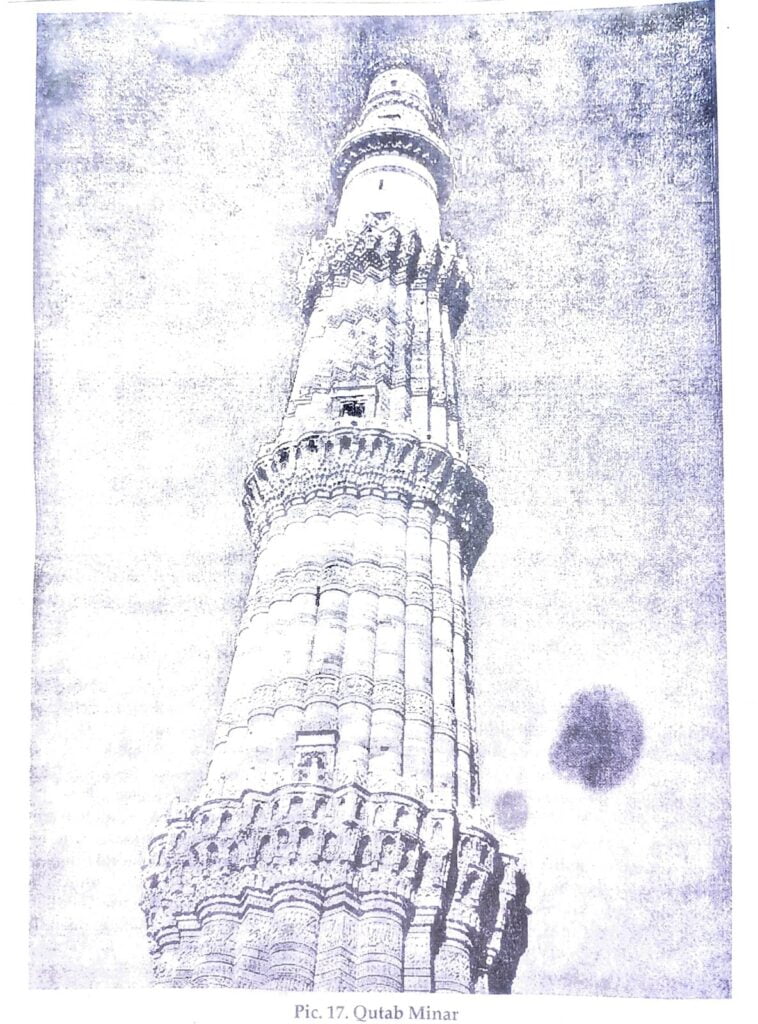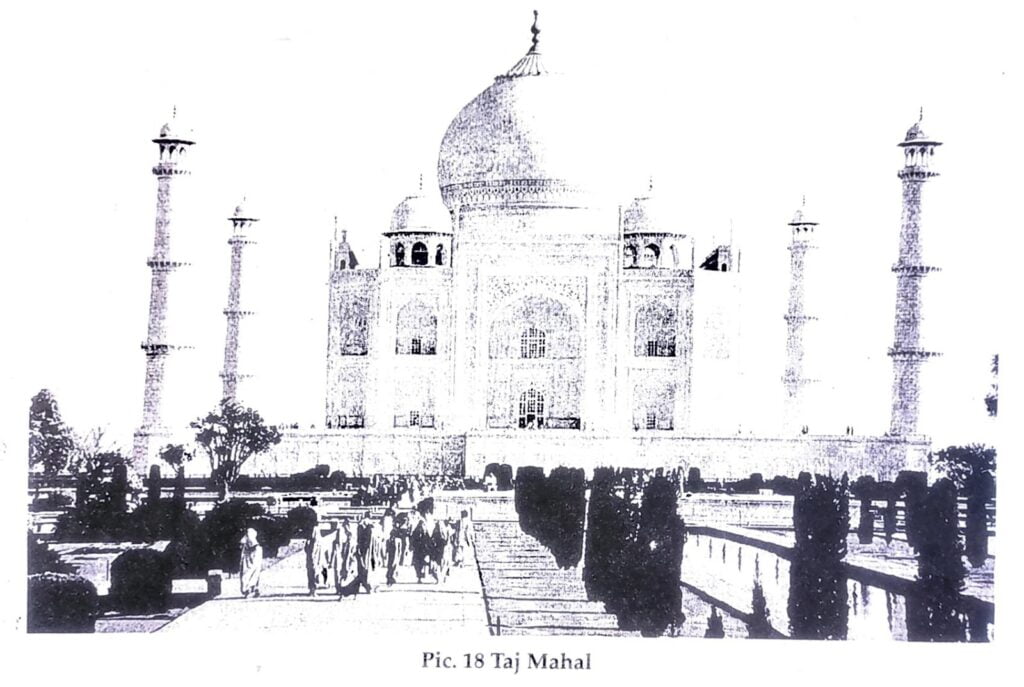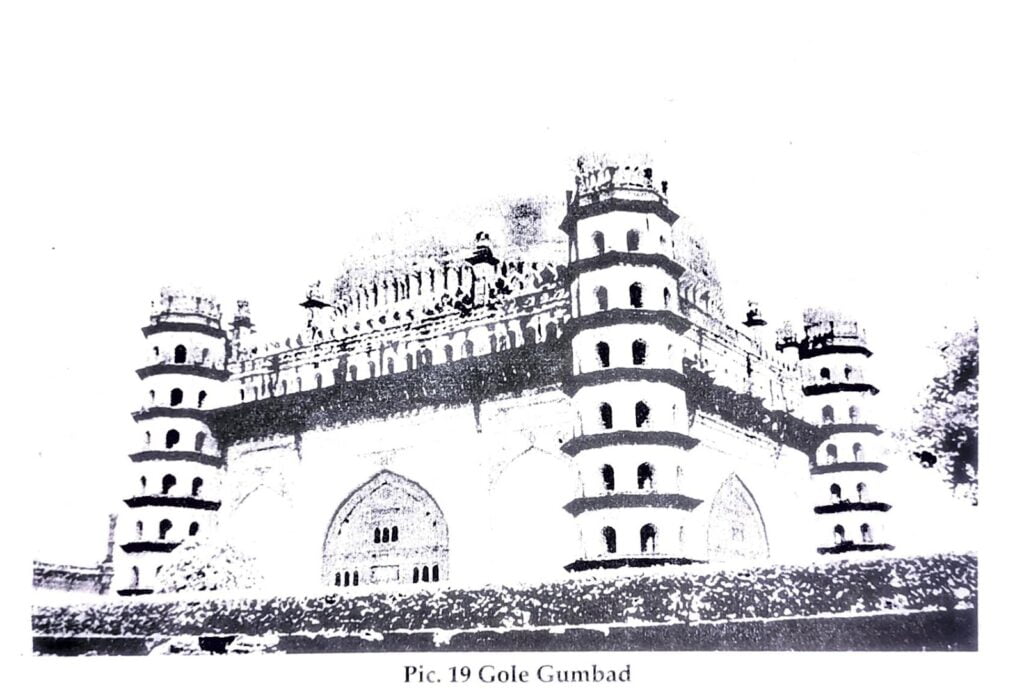NIOS Class 12 Painting Chapter 6 Indo-Islamic Architecture Solutions to each chapter is provided in the list so that you can easily browse throughout different chapters NIOS Class 12 Painting Chapter 6 Indo-Islamic Architecture and select need one. NIOS Class 12 Painting Chapter 6 Indo-Islamic Architecture Question Answers Download PDF. NIOS Study Material of Class 12 Painting Notes Paper 332.
NIOS Class 12 Painting Chapter 6 Indo-Islamic Architecture
Also, you can read the NIOS book online in these sections Solutions by Expert Teachers as per National Institute of Open Schooling (NIOS) Book guidelines. These solutions are part of NIOS All Subject Solutions. Here we have given NIOS Class 12 Painting Chapter 6 Indo-Islamic Architecture, NIOS Senior Secondary Course Painting Solutions for All Chapter, You can practice these here.
Indo-Islamic Architecture
Chapter: 6
PAINTING
Qutub Minar (Pic. 17)
| Title | Qutub Minar |
| Medium | Red and White Sand stone |
| Date | 1206 to 1232 AD. |
| Finding site | Delhi |
| Size | Height-72.56 meters |
Qutub-ud-din Aibek, the first of the slave Dynasty ruler, first of all started getting this minar constructed as a ‘symbol of Victory’ but later he gifted it to his Dilli (Delhi) master Sufi Saint-Bakhtiyar Kaki. This minar is known as Qutub-minar’. This minar is a fine example of Indo-Turkish style of Architecture. Its boldly projected balconies on each storey, carved arabic scriptures on stones (they are mostly inscriptions from Quran and titles of the Emperor) and rope-winding stair-cases are its special features. This is the highest minar of India measuring 71.3 meters high.
Red and white sand-stones are used in building the Qutub-minar. On its top floor marble stones are also used. Stucco lime-mixture as mortar for cementing its constructional work has been used.
Qutub-ud-din Aibek could get only its first storey constructed during his rule-1206 to 1210 AD Afterward king Iltutmish got the 2nd, and 4th storeys completed. But at the end (though badly conceived) 5th storey was built by Emperor Firozeshah Tughuluk of Tughlaq dynasty.
Qutub-minar is situated at Mehrauli in Delhi.
Style of Architecture
Qutub-minar is well-known for its ‘Shankh’ like form’.
Its strong ribs supporting its balconies; geometrical decorative carvings and arabic inscriptions along with pure Indian decorative symbols in its stylistic construction.
Taj Mahal (Pic. 18)
| Title | Taj Mahal |
| Medium | White marble stone |
| Date | 1632 to 1654 AD |
| Finding site | Agra |
| Size | Ground plan 580×305 meters, Height-187 |
Mughal Emperor Shah Jahan is a well known figure until today for its great construction activities especially for Taj Mahal. He got Taj Mahal constructed as a memorial for his beloved wife Mumtaz Mahal. In this building there are two tombs (graves)-one of his wife Mumtaz and the other of his own. Such memorial buildings constructed over the tombs are called “Maqbaras”. Construction of Taj Mahal is a fine mixture of Indian and foreign styles of architectural art.


White marble stone from Makrana mines in Rajasthan was brought for the construction of Taj Mahal, and lime stucco was used as mortar for cementing its walls.
Shah Jahan ruled from 1628 to 1658 A.D. and. It took twenty two years for the construction of Taj Mahal. This beautiful building is situated on the bank of Yamuna river in the city of Agra. The area of the main building is 313 square feet. There are many domes, the highest dome of the building is 186 feet high.
At the four corners of the buildings there are four minars each having 163 ft. height. The double layered domes and minarets are built in Iranian style, but its arches and balconies are in Persian style. The main emphasis of this building has been especially laid on the layout proportions of its different parts and on the beautiful arabic inscriptions. Geometrical decorative motifs and some other constructional aspects like cubical brackets, designing of the basemens and the high level of platform are some of the finest representations of Indian style of architecture.
Gole Gumbad (Pic. 19)
| Title | Gole Gumbad |
| Medium | Baked bricks |
| Date | 17th C.A.D. |
| Finding site | Bijapur |
| Size | Inner area 1600 sq. Meter |
During 14th century A.D., there were many small kingdoms in South India. One of these kingdoms was known as Bahmani Kingdom. The Bahmini king constructed Gol Gumbaz Besides the Indian architectural style, the ‘Gole Gumbad’ of Bijapur had the influence of Egyptian, Turkish and Persian architecture.
In the construction of Gole Gumbad, baked bricks have been used which have been cemented with lime stucco.

It was built by Muhammad Adil Shah of Bijapur in the 17th C.A.D. It is situated at Bijapur city of Karnataka.
Style of Construction
The double layered roofing style of Iran had been used in construction of Gole Gumbad. This is the biggest dome among all the domes of the world in which the inner layer of the dome is rounded in semi-circular form whereas the outer layer is conically narrowed upward giving it à bulbous look. There are four octagonal minars at the four corners. Each have seven storeys. The inner total area of this building is 1600 square. meters.
Intext Questions 6.1
Tick mark the right answer:
1. Qutub Minar was built as a symbol of
(a) Victory.
(b) Love.
(c) Religion.
Ans: (a) Victory.
2. Top floor of Qutub Minar is built of
(a) Sand stone.
(b) Marble.
(c) Bricks.
Ans: (b) Marble.
3. This minar is good example of
(a) Mughal architecture.
(b) Hindu architecture.
(c) Indo-Turkish architecture.
Ans: (c) Indo-Turkish architecture.
Intext Questions 6.2
Fill in the blanks:
1. Shah Jahan built Taj Mahal as a ________ of his wife ________.
Ans: Memorial, Mumtaz.
2. Taj Mahal is situated on the bank of ________ in the city of ________.
Ans: Yamuna river, Agra.
3. Taj Mahal is built of ________ stone.
Ans: White marble stone.
Intext Questions 6.3
Tick mark the right answer:
1. In the construction of Gole Gumbad the
material is used
(a) Marble.
(b) Baked bricks.
(c) Granite.
Ans: (b) Baked bricks.
2. It was built by
(a) Ibrahim Adil-Shah.
(b) Muhammad Adil Shah.
(c) Yusuf Adil Shah.
Ans: (b) Muhammad Adil Shah.
3. It is situated at
(a) Agra.
(b) Bijapur.
(c) Golconda.
Ans: (b) Bijapur.
Model Questions
1. Keeping in mind the Indo-Turkish style of architectural art, explain the main features of the architecture of Qutub-minar.
Ans: Qutub-ud-din Aibak, the first of the slave Dynasty ruler, first of all started getting this minar constructed as a ‘symbol of Victory’ but later he sponsored it to his Dilli (Delhi) master Sufi Saint-Bakhtiyar Kaki as a gift. This minar is known as ‘Qutub-minar’. This minar is a good example of Indo-Turkish style of Architecture. Its boldly projected balconies on each storey, carved arabic scriptures on stones (they are mostly inscriptions from Quran and titles of the Emperor) and rope-winding stair- cases are its special features. This is the highest minar of India measuring 71.3 meters high.
Red and white sand-stones are used in constructing the Qutub-minar. On its top floor marble stones are also used. Stucco lime-mixture as mortar for cementing its constructional work has been used.
2. Write down the three main reasons of calling ‘Taj Mahal’ as a very good example of Mughal architecture’.
Ans: White marble stone from Makrana mines in Rajasthan was brought for the construction of Taj Mahal, and lime stucco was used as mortar for cementing its constructional work.
3. The Dome of Gole Gumbad of Bijapur is double layered roofing dome. Keeping this fact in mind draw a picture and write about the style of double layered bulbous dome.
Ans: At the four corners of the buildings there are four minars each having 163 ft. height. The double layered domes and minarets are constructed in Iranian style, but its arches and balconies are in Persian style. The main emphasis of this building has been especially laid on the layout, proportions of its different parts and on the beautiful arabic inscriptions. Geometrical decorative motifs and some other constructional aspects like cubical brackets, designing of the basements and the high level of platform are some of the best representations of Indian style of architecture.
4. Write the name and color of stone used in the construction of Taj Mahal.
Ans: The double layered roofing style of Iran had been used in construction of Gole Gumbad. This is the biggest dome among all the domes of the world in which the inner layer of the dome is rounded in semi-circular form whereas the outer layer is concially narrowed upward giving it a bulbous look. There are four octagonal minars at the four corners which have seven storeys each. The inner area of this building is 1600 square meters.
Very Short Type Questions Answer
1. When did the foreign cultures start to invade into India?
Ans: During 8th century Turkish, Arabian and Mongolian cultures started invading into the main cultural stream of India.
2. What type of architectures were built during Indo-Islamic era?
Ans: Mosques, palaces, tombs, maqbarasi madrasas and fort/fortresses.
3. What is medium of Qutub minar?
Ans: Red and white sand stone.
4. When was Qutub minar built?
Ans: During 1206 to 1230 A.D.
5. Why is Qutub minar so famous?
Ans: Qutub-minar is most famous for its ‘Shankh like form.
6. Who built the first storey of Qutub minar?
Ans: Qutub-din-Aibek.
7. Who built 2nd, 3rd and 4th storeys of Qutub minar?
Ans: King Iltumish.
8. Who completed Qutub Minar?
Ans: Ferozeshah Tughuluk.
9. Where is Qutub minar situated?
Ans: Qutub minar is situated at Mehrauli in Delhi.
10. What are ‘Maqbarasi’?
Ans: Maqbarasi are memorial buildings constructed over the tombs.
11. When was Taj Mahal built?
Ans: During 1628 to 1658.
12. How many miners are there in Taj Mahal?
Ans: Four minars.
13. Which foreign cultures influenced construction of Gole Gumbad?
Ans: Egyptian, Turkish and Persian.
14. Which is the biggest dome of the world?
Ans: Gole Gumbad.
Short Answer Type Questions
1. Why was there mixture of various cultural influences in architectural works of Medieval India?
Ans: During 8th century A.D. Turkish, Arabian and Mongolian cultures started invading into the main cultural stream of India. When these foreign cultural people started living in India during medieval period, they employed local Hindu masons for constructing their architectural marvels i.e. mosques, palaces, tombs, maqbaras, madrasas and forts/fortresses. It is because of this reason that we see the mixture of various cultural influences in these architectural works of medieval India.
2. What types of architecture could be seen in medieval India?
Ans: In medieval India, a new Indianised style of semicirculo-mes, mehrabs, (conical minars which were earlier being used for temple niche of the Buddhists or Hindu deities) came into existence. Squirish forms of columns, mosques without minarets, small arched niche (semi-circular) conical columns, are some of the other examples of the mixture of cultural style.
3. What is style of architecture of Qutub Minar?
Ans: Qutub-minar is most famous for its ‘Shankh’ like form. Its strong ribs supporting its balconies; geometrical decorative carvings and arabic inscriptions along with pure Indian decorative symbols in its stylistic construction.
4. Why was Taj Mahal built?
Ans: Mughal Emperor Shah Jahan is a well known figure until today for its building construction activities especially for Taj Mahal. He got Taj Mahal constructed as a memorial for his beloved wife Mumtaz Mahal. In this building there are two tombs (graves)-one of his wife Mumtaz and the other of his own. In fact such memorial buildings constructed over the tombs are called ‘Maqbaras. Construction of Taj Mahal is a fine blend of Indian and foreign styles of architectural art.
5. Describe the construction of Taj Mahal.
Ans: Mughal Emperor Shah Jahan is a well. known figure until today for its building construction activities especially for Taj Mahal. He got Taj Mahal constructed as a memorial for his beloved wife Mumtaz Mahal. In this building there are two tombs (graves)-one of his wife Mumtaz and the other of his own. In fact such memorial buildings constructed over the tombs are called ‘Maqbaras’. Construction of Taj Mahal is a fine blend of Indian and foreign styles of architectural art.
White marble stone from Makrana mines in Rajasthan was brought for the construction of Taj Mahal, and lime stucco was used as mortar for cementing its constructional work.
Shah Jahan ruled from 1628 to 1658 A.D. and during this period he spent twenty two years for the construction of Taj Mahal. This beautiful building is situated on the bank of Yamuna river in the city of Agra. The area of the main building is 313 square feet. The highest dome of the building is 186 feet high.
At the four corners of te buildings there are four minars each having 163 ft. height. Th double layered domes and minarets are constructed in Iranian style, but its arches art balconies are in Persian style. The main emphasis of this building has been especially laid on the layout, proportions of its different! parts and on the beautiful arabic inscriptions Geometrical decorative motifs and some other constructional aspects like cubical bracket designing of the basements and the high level of platform are some of the best representations Indian style of architecture.
6. Describe construction of Gol Gumbad
Ans: During 14th century A.D. there wer many small kingdoms especially in South India One of these kingdoms was known as Bahmani Kingdom. Besides the Indian architectural style the ‘Gole Gumbad’ of Bijapur had the influence, of Egyptian, Turkish and Persian architecture as well which was built by the Bahmini king!
In the construction of Gole Gumbad, bake bricks have been used which have bee cemented with lime stucco.
Muhammad Adil Shah of Bijapur built the Gole Gumbad in the 17th C.A.D.
It is situated at Bijapur city of Karnataka
Style of Construction
The double layered roofing style of Ira had been used in construction of Gol Gumbad.
In India, this is the biggest dome among all the domes of the world in which the inner layer of the dome is rounded in semi-circular form whereas the outer layer is concially narrowed upward giving it a bulbous look. There are four octagonal minars at the four corners which have seven storeys each. The inner area of this building is 1600 square. meters.
7. Describe the construction of Medieval India.
Ans: In the history of architectural art of India during medieval period, the construction of mehrabs, domes and the mixtures of cementing mortars are the gifts of Turkish techniques. We can simultaneously very well see the swastika symbol, bell shape forms, lotus carvings and kalash (a pious earthen pituitary shapes) used are decorative motifs which are purely Indian in their style and forms, gifted to the Indo-Islamic Architecture. Many tombs- mehrabs and maqbaras were constructed and their surroundings were developed into beautiful decorative parks/gardens. But special attention was laid on the strength of the buildings during construction time.
8. What type of materials were used to construction Gole Gumbad?
Ans: In the construction of Gole Gumbad, backed bricks have been used which have been cemented with lime stucco.

Hi! my Name is Parimal Roy. I have completed my Bachelor’s degree in Philosophy (B.A.) from Silapathar General College. Currently, I am working as an HR Manager at Dev Library. It is a website that provides study materials for students from Class 3 to 12, including SCERT and NCERT notes. It also offers resources for BA, B.Com, B.Sc, and Computer Science, along with postgraduate notes. Besides study materials, the website has novels, eBooks, health and finance articles, biographies, quotes, and more.


